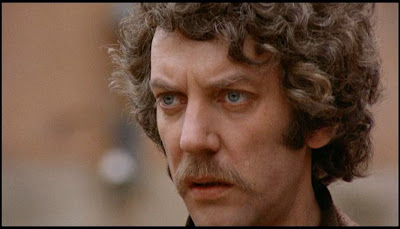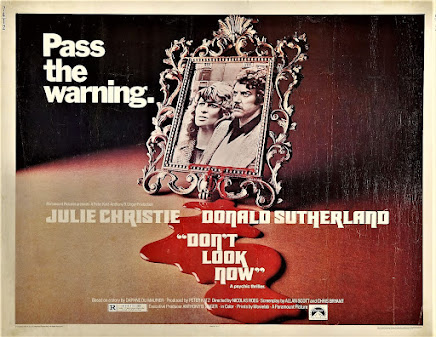There is nothing like a good scare at the movies. I don't mean those jarring, throw-your-popcorn-in-air, dig-your-nails-into-your-partner's-arm, moments (ah, sweet memories of Wait Until Dark). As fun as they can be, those moments are over much too swiftly. What I refer to are those far more satisfying, lasting feelings of intensifying disquietude that overtake you the moment a movie starts to touch upon an anxiety or sense of dread that runs deeper than mere surprise in the face of the unexpected. Those moments when the passive role of observer — the moviegoer's emotional safety valve—give way to the more interactive role of the projected participant. Suddenly, you're relating to the film on a visceral level, and all the while an electric current running through you is taking great delight in your being brought to such a vulnerable state of apprehension by mere flickering images projected on a screen.
It happened once when I was a kid and saw Rosemary's Baby and it happened again as an adult with Nicolas Roeg's Don't Look Now. an opaque, atmospheric thriller that proves when it comes to scary stories, it's all in the telling.
 |
| Julie Christie as Laura Baxter |
 |
| Donald Sutherland as John Baxter |
 |
| Hilary Mason as Heather, the blind woman with "second sight" |
 |
| Clelia Matania as Wendy |
An off-season assignment to restore a decaying church in Venice Italy affords architect Donald Sutherland and wife Julie Christie the opportunity to leave behind mournful memories associated with their English country home—the site of a recent tragedy--the accidental drowning death of their young daughter. However, Venice
The unforeseeable foreseen.
A sense of something not being right.
An accident. A premonition. A fate.
PERFORMANCES
I claim no objectivity when it comes to Julie Christie. To the head-scratching bewilderment of my partner, who thinks she's fine enough but nothing to rave about, I find her to be an intelligently resourceful actress who brings an air of emotive conviction to everything she does. And it certainly doesn't hurt that she is a stone knockout, to boot. Her matter-of-fact naturalness proves an essential asset in a film such as this, lest her character be made to appear hysterical or unbalanced. Donald Sutherland underplays so well (usually, anyway) that the skill of his performances are often overlooked. In Don't Look Now he is at his relaxed best, making his character a believable skeptic in the face of the fantastic. Watch the play of emotions over his face as his character tries to sort out the mystery that his life has become. It's just the kind of in-the-moment urgency that is lacking in so many suspense films. Sutherland seems to be right with us, the audience, not a step ahead nor a step behind. I think he's fantastic here.
A woman without sight watches.
The city is full of windows but no one sees the murderer.
A child drowns because no one is watching.
Much of Don't Look Now concerns itself with the concept of perception. Most certainly self-perception (Sutherland's character's fatal flaw is ignoring his own sixth sense) and awakening to the danger inherent in not heeding signs of warning, not being watchful, not seeing, not looking.
The unforeseeable foreseen.
A sense of something not being right.
An accident. A premonition. A fate.
WHAT I LOVE ABOUT THIS FILM
What one considers scary is as subjective a designation as what one considers to be funny, so I'm aware my claim of Don't Look Now being one of the scariest movies I've ever seen is not the same thing as saying it's a scary movie. I'm certain that for many its premise and execution are far too leisurely and bloodless for the Texas Chainsaw Massacre crowd, and the label of "arty" would not be baseless in describing both its structure and visual style. But for whatever reason or whatever chord it struck, this darkly mysterious merge of the rational and paranormal just scared the bejesus out of me when I first saw it. And continues to do so even today.  |
| Venice in Peril A sign calling attention to the endangered status of Venice architecture also alludes ominously to the serial killer terrorizing the city. |
PERFORMANCES
I claim no objectivity when it comes to Julie Christie. To the head-scratching bewilderment of my partner, who thinks she's fine enough but nothing to rave about, I find her to be an intelligently resourceful actress who brings an air of emotive conviction to everything she does. And it certainly doesn't hurt that she is a stone knockout, to boot. Her matter-of-fact naturalness proves an essential asset in a film such as this, lest her character be made to appear hysterical or unbalanced. Donald Sutherland underplays so well (usually, anyway) that the skill of his performances are often overlooked. In Don't Look Now he is at his relaxed best, making his character a believable skeptic in the face of the fantastic. Watch the play of emotions over his face as his character tries to sort out the mystery that his life has become. It's just the kind of in-the-moment urgency that is lacking in so many suspense films. Sutherland seems to be right with us, the audience, not a step ahead nor a step behind. I think he's fantastic here.
THE STUFF OF FANTASY
There's a chilling sequence in which the couple venture out at night, looking for a restaurant they've heard about. The dark streets and alleys prove an insurmountable maze and they become lost and eventually separated. In the midst of this, an unearthly cry is heard and something terrifying is half seen. This scene just had my pulse racing. It is a brilliant bit of cinematic tension. |
| Things only half seen and half heard. |
THE STUFF OF DREAMS
The film's title is really splendid. No matter how you say it, literal or ironic, whatever you think it means, whatever punctuation you add, or wherever you place the emphasis; it remains 100% appropriate to the film's themes. It speaks of warning, apprehension, sight, and danger. All elements of the film evocatively rendered in the recurring perception motifs of eyes, watching, seeing, and reflecting. A woman without sight watches.
The city is full of windows but no one sees the murderer.
A child drowns because no one is watching.
Much of Don't Look Now concerns itself with the concept of perception. Most certainly self-perception (Sutherland's character's fatal flaw is ignoring his own sixth sense) and awakening to the danger inherent in not heeding signs of warning, not being watchful, not seeing, not looking.
Don’t Look Now is one of those movies so rich in content that it yields dividends with each re-visit. This brief insert shot reveals details of Donald Sutherland's nightstand: a photo of his children with the drowned daughter's face obscured. A glass of water with a symbolically significant red base. A paperback copy of Der Stellvertreter (subtitled, A Christian Tragedy) by Rolf Hochhuth - a play alleging the Catholic Church turned its back on (failed to heed, refused to see) the warning signs of The Holocaust. Playing further into the themes of not looking and paying little heed, in a later scene, a Catholic Bishop pondering the violence in the world wonders aloud if perhaps God has "other priorities" or perhaps "we have stopped listening."
A thriller in every sense of the word, Don't Look Now is one of those rare suspense films that doesn't lose its punch after it's revealed its mystery. Indeed, that's precisely the point when more questions are likely to spring to mind. Whatever level it's approached by -- a mood piece, a study of grief, a psychic mystery, a ghost story -- Don't Look Now delivers as a chilling, remarkably effective, and atmospheric suspenser that's as much a treat for the eyes (Venice has never looked more hauntingly beautiful) as the imagination. But keep your eyes peeled.
























































